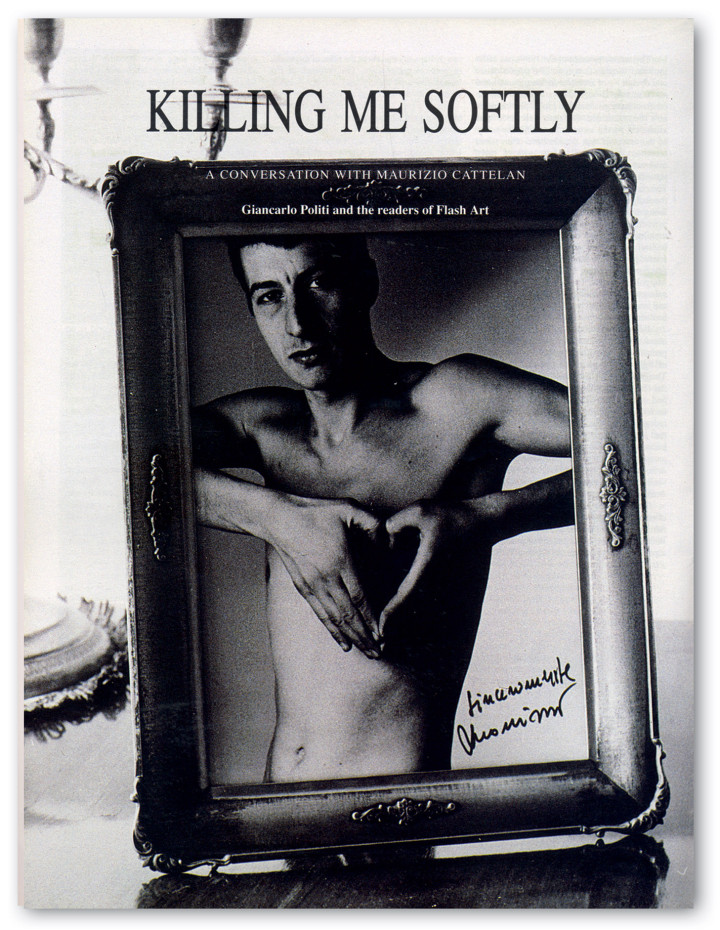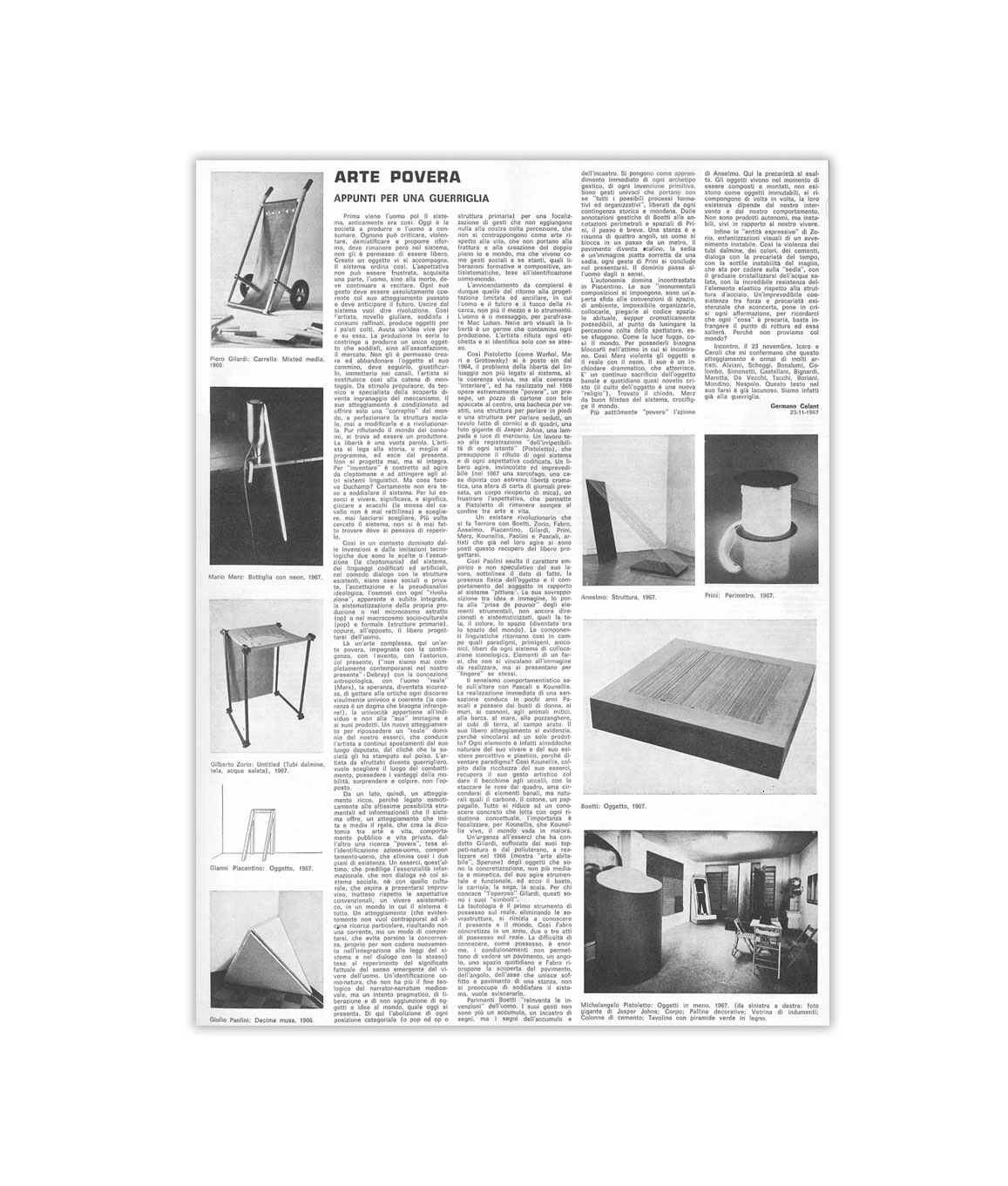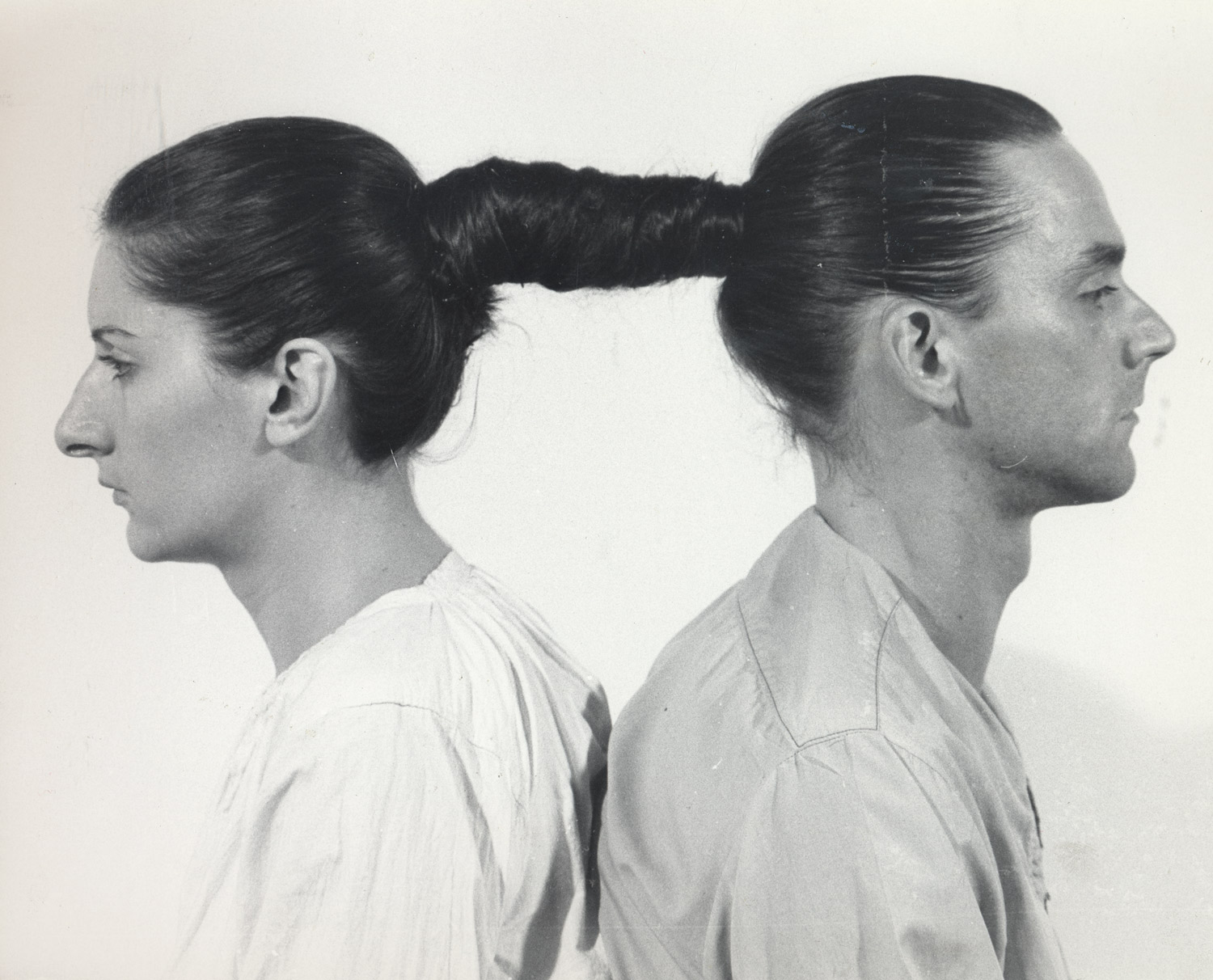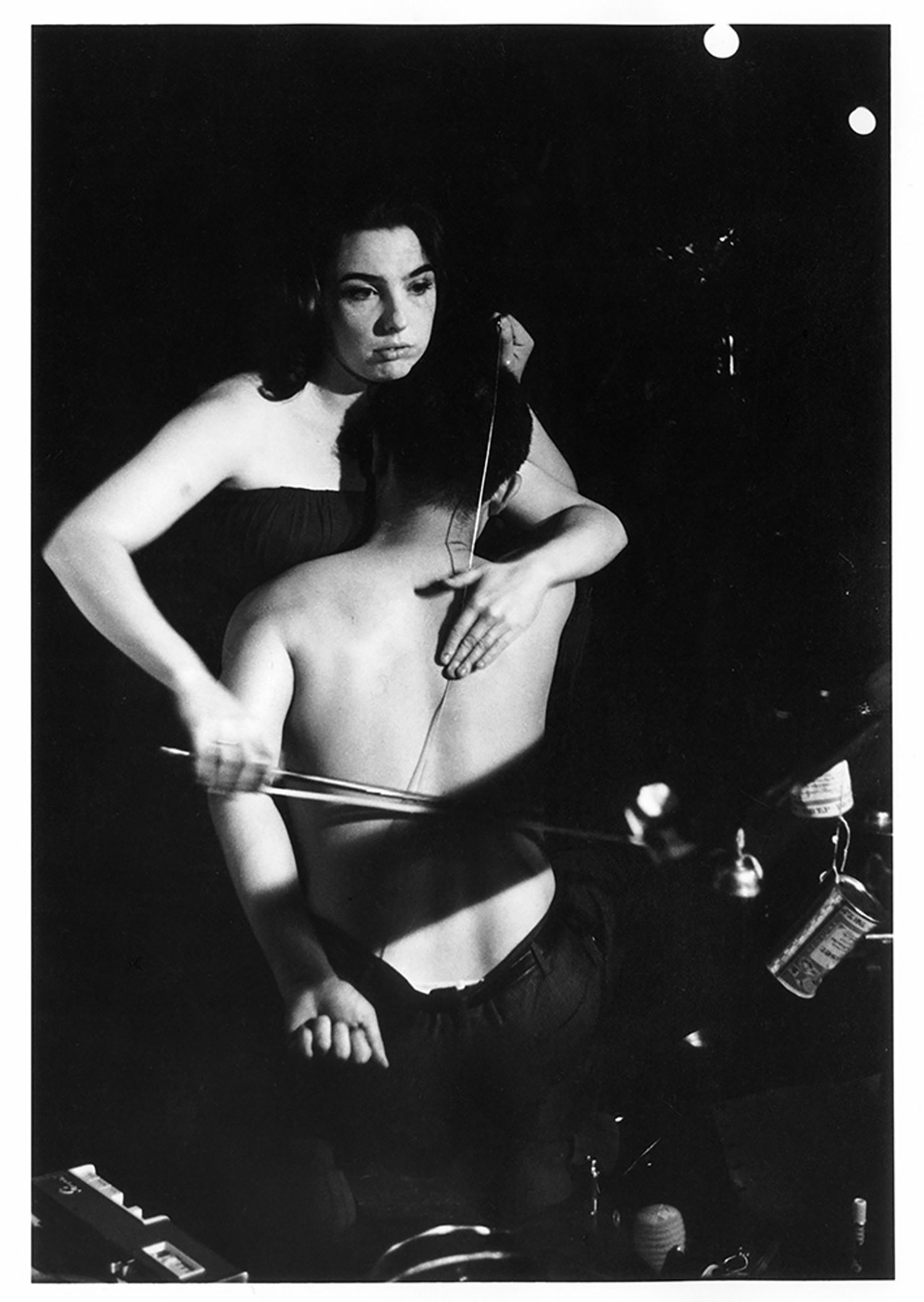
LIFE: A USER’S MANUAL
Karl J. Volk, New York: I am afraid that I do not know who Maurizio Cattelan is. I would like to know.
Maurizio Cattelan: A lazy overachiever running downhill.
Patrick Prince, San Diego: How was your life before you became a successful artist?
MC: I was a loser, most concerned with making a living. It took me 30 years to understand that if I was a failure it wasn’t my fault. I had to reinvent a system, find a way out, and set some rules that could work for me and a few others. I guess in the end that’s what we all are trying to do.
Joop van Allen, Amsterdam: How do you manage your daily life?
MC: I’m quite maniacal and repetitive. I free myself from anything that can disturb me. I try not to own anything.
Dirk Böckler, Cologne: What should an artist do to become successful?
MC: I don’t have any recipes, also because I don’t think I did anything special. Just try to become someone else.
HOME SWEET HOME
Claudio Sichel, Italy: How much has the Paduan art scene of the ’80s influenced your work?
MC: I don’t believe in scenes or groups. Besides, in Padua I was taking evening classes to become an electrician. There wasn’t much time for art.
Martine Deny, Luxembourg: What attracted you to art?
MC: I got to art via trial and error. Maybe it was simply the last port of call. They accepted me, with my doubts, my fears, and I think that made the difference.
WE ARE TOO MANY
Samuel Bryson, London: For many years on the occasion of public appearances you have sent Massimiliano Gioni in your place with the purpose of impersonating you. How did this personality-splitting game start, and what significance do you give to it?
MC: We haven’t split, just multiplied. For me there’s no secret meaning or deceit behind this gesture; it’s just a way to solve a problem. I don’t know how to talk in public, so someone else can go and do it better. And when Massimiliano answers, he also copies, recycles, and invents. The fact is that I am terribly scared of boredom. To hear someone else describe your work is always a surprise. And I think people need more doubts and fewer certainties.
Sonja Wessel, Vienna: Who’s answering now? You? Someone else? Massimiliano Gioni?
MC: The answer is inside of you, and it’s wrong.
COME AS YOU ARE
Susan Kendzulak, Taipei: Why?
MC: Because I can’t do anything else.
Stéphane Ollivier, France: For you, what is the aim of art today?
MC: The word ‘aim’ makes me think of shooting a gun. I’m not so interested in targets or aims. I prefer mistakes.
Carla Roncato, Milan: What were you thinking about when you hammered the hands of the kid [in Charlie Don’t Surf, 1997] to his school desk?
MC: I was wondering what hurts more: a pencil through a hand or failing first grade.
Bettina Funcke, New York: What was the most intriguing copyright problem you ran into during your career as an artist?
MC: I’ve never really had any trouble, also because I’m not the kind of person who steals or copies systematically. In the end we are all part of the same digestive system, and each one of us consumes images and ideas however we want, spitting them out completely traånsformed. Many things I did have been chewed and digested by others. What matters is to assimilate the right quantity of calories. Taste is not so crucial.
Helen Ruth, Minneapolis: What’s art useful for?
MC: If I knew, I’d be a collector.
Carlo Piemonti, Gorizia, Italy: Is art possible today without marketing?
MC: And life without death? Nothing is necessary, but everything is useful.
Autumn Rooney, Brooklyn: Did anyone in particular, artist or otherwise, have an influence on you before you established yourself in the art world?
MC: I try to learn from everyone, really. Being self-taught can be an advantage. You don’t have debts to pay. You have no professor, and everyone becomes a classmate.
Matthieu Laurette, Paris: What is your favorite artwork? Who is you favorite artist?
MC: Names change continuously; it’s impossible to make charts. Warhol is maybe the name that comes back more often, but in his hands even dying seemed chic.

DEATH BECOMES HER
Teresa Goltieri, Italy: What do you think of death? Is it an end or a beginning?
MC: It’s an exclamation mark. It gives sense to everything but takes away the suspense.
Holly Golightly, New York: For Blanchot, the corpse shows what hides in words and images: being present and elsewhere at the same moment. Is this the game you play between reality and fiction?
MC: I dealt with corpses, real ones, when I worked in a morgue, and they seemed so deaf, distant. Maybe it’s all that job’s fault, but when I think of a sculpture, I always imagine it like that, far away, in some way already dead. It has always surprised me when people laugh at some of my art works; maybe in front of death laughter is a spontaneous reaction.
Topylabrys: For years I have been working with plastic materials and food as material. I’d like to know what you think about using such materials for producing art?
MC: No, thanks, I’ll just have a coffee.
THE MAN WITHOUT QUALITIES
Genco Gülan, Istanbul: How are you?
MC: Quite tired, indeed.
Martina Rapaggi, London: Do you often laugh on your own?
MC: No, not much. I can’t do much on my own. It seems that the most interesting things happen when there are at least two or three people in the same room.
Andrew Eyman: Where do you see yourself today? And what about in 20, 50, 100 years? Is it a goal of yours to be remembered and considered an important artist of our time?
MC: It would already be a good result to be remembered at the end of the year. Unfortunately, I don’t think it will last that long, and maybe it’s not that important. I try to make a contribution to the present.
Angel Rock, Chicago: What relationship do you have with money?
MC: I have a strange relationship with money. I’m almost scared of it, and I have forced myself to live as though nothing really changed. Of course, money is a great vehicle for communication, probably even more effective than religion. But then it is not so important how much money you have, but how and where the money goes.
Mary Houston, Santa Monica: The Ballad of Trotsky was sold at auction for 2 million dollars. How does it feel to be in the shoes of an artist whose pieces are worth millions of dollars, when just a few years ago it was difficult to sell even one piece for a few dollars? From Cinderella to princess?
MC: To tell you the truth, I still go around by bicycle, with neither horse nor carriage. Of course you feel a different pressure and another responsibility. Mostly because money doesn’t really open more doors or make challenges any easier. Actually, it risks trapping you; it makes you too coherent. This is why I tried not to change the way I live. I can’t stand distractions.
Ruben Perrel, New York: How much money do you make?
MC: It could be more interesting to know how much I spend, which is very little. But that will be for another time.
Juan Escovedo, Granada: Which critical comments have you hated the most?
MC: I am a bit tired of those that speak only of money or that say I am a clown or a bluff. For some reason, it seems impossible to believe that I am just trying to say what I think. But then again, maybe it’s better that way; at least I can occasionally say something serious without anyone noticing.
Cécile Bernard, Paris: In an interview with Vanessa Beecroft, similar to this one, a reader asked, “Don’t you think Flash Art has given you too much space?” She answered, “And what about Cattelan?” So: don’t you think Flash Art has given you too much space?
MC: Probably, yes. I deserve at most a one-room apartment. Instead Flash Art gave me a loft. But sooner or later eviction will come.
Stephen von Land, Düsseldorf: Which of your works are you most attached to, or which do you think worked out best?
MC: Each time is a surprise, also because I don’t touch any of my pieces; it’s always someone else who produces my work. Therefore, I don’t feel particularly attached to what I do. It belongs to someone else right from the start. Some works serve at a precise moment; others grow little by little, and if you are lucky they last longer. Above all I like seeing how artworks change meaning depending on what happens around them. It’s as though they have many lives.
Jennifer Benavente, New York: Your piece in the Whitney Biennial was hidden from view, with only a wall plaque to indicate its presence beneath the gallery floorboards. Usually, though, your works are highly visible and confrontational. Can you explain your decision to make this anti-statement?
MC: The word ‘show’ has always got on my nerves. It’s so exhibitionist and impertinent. Maybe that’s why my works, also the most confrontational ones, are placed in corners or on ceilings, always de-centered. I like losing balance, falling, and maybe even disappearing.

SYMPATHY FOR THE DEVIL
Giancarlo Politi, Milan: Maurizio, I would’ve hoped that Mr. Franco De Benedetto — clumsy art revenger, nouveau exponent of today’s ku-klux-klan of cultural intolerance — when falling from the tree of your wonderful angels on Milan, would’ve smashed against the floor or even better against the forgotten Milanese Renaissance monument right under the tree. What better occasion could there be for an alcoholic in an exhibitionist mood to become a martyr of today’s art? History is full of saints in spite of themselves! In this moment of great religious and political emotion, with followers who shout and tear themselves to pieces, a saint in art would’ve fitted well. Imagine the crowd of frustrated artists, underfed critics, well-thinking citizens, and studied followers of the Lega party who would’ve joined — in the name of artistic and religious justice — the Milanese funeral, crying and sanctifying an alcoholic. It would’ve been the sign of our time and story. In short, we’ve lost part of the spectacle your work deserved, or maybe even foretold. Don’t you think?
MC: I don’t like funerals at all, and at the moment the world is full of martyrs doing much more terrible things. Maybe it’s time to make less noise. The children on the tree were so silent, in spite of the traffic all around. Maybe it’s necessary to start from there. You obviously can’t chop your ear off every day, always be a hero, or an exhibitionist. I am an apostle of silence.
Saramicol Viscardi, Milan: Was the scandal of the installation in Piazza XXIV Maggio aiming to increase your fame as an enfant terrible?
MC: No, not at all. Actually, it was just a way to take a position and say something clear about what we are doing to our future. It was a crucifixion, maybe a ritual sacrifice. It wasn’t supposed to bring attention to me, but to the world out there.
David Spike, Miami: Were you expecting such a reaction?
MC: I was expecting discussions and debate. That it would become a political confrontation, probably not. But I think it was really interesting. Art has also this task. It has to become a catalyst for different opinions, a mirror of our paranoias. Mostly it surprised me that an artwork could open a confrontation on freedom of expression. We are living in a moment where rights are taken for granted and often forgotten. Occasionally it is useful to stop and discuss them.
Katharina Schreyer, Zurich: After what happened with the hung dummies/children, does Milan not respect or deserve you as an artist?
MC: I don’t believe in generalizations. In Milan there are people who hated the piece and people who would like to continue seeing it in Piazza XXIV Maggio. And then, before hanging the children, there were months and months of meetings, discussions and permissions; the Trussardi Foundation has been working on the project since January. And we met many people who still believe that art can tell us something about the world.
Louis Chang, Los Angeles: Your sculptures have been attacked on two separate occasions. How does it feel to be in such rarefied company, along with Malevich, Michelangelo, Mondrian, and Rembrandt?
MC: Wherever there’s art, there’s iconoclasm. Images are always victims of attacks, sometimes symbolic, other times physical. Personally I am affected by an acute form of iconofilia. If I don’t see at least a hundred images in a day, my face gets covered with blotches.
Angelo Errico, Italy: Is today’s society more emotionally mature than the one that cheered the guillotines in public squares?
MC: I don’t think much has changed. Once you watched executions in squares. Nowadays you watch them on TV.
from Flash Art International n°237, 2004





